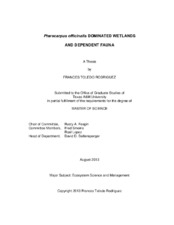| dc.description.abstract | Pterocarpus officinalis dominated forests are a rare ecosystem, found only in fifteen locations in Puerto Rico, all of which are adjacent to the coast and at risk from sea level rise, as well as nutrient pollution, upstream hydrological modifications, and deforestation. All forests of this type that were located further inland were destroyed by agricultural development during the early decades of the 1900’s, in particular to grow sugarcane. Prior to this study, there was little information on the diversity of organisms that live in these forests. The central objective of this proposal was to examine the diversity and species composition of three Pterocarpus forests in Puerto Rico located near Humacao, Patillas, and Dorado, and to compare and contrast diversity among the three forests, and identify possible differences caused by human impacts or natural factors. The data was collected through surveys and sampling at each location. Transect surveys, plots, pitfall traps, insect traps and audio recordings were carried out to identify organisms including birds, mammals, amphibians and reptiles, insects, mollusks, invertebrates, plants and fungi.
The Dorado Pterocarpus forest is the most rich and diverse in terms of organisms and has the highest amount of native and endemic species, while the Humacao Pterocarpus forest is the least rich and diverse. Yet conversely, the Dorado forest is the smallest forest, covering only 2.4 ha, while Humacao is the largest, with an area of 150 ha that comprises 63% of the total Pterocarpus coverage in Puerto Rico. The most obvious factor influencing richness and diversity among the forests is the adjacent land cover and history of the sites. Inflow and water sources may also be a factor that alters richness and diversity. This knowledge will assist in the appropriate management of this rare resource in the context of ongoing sea level rise, climate change, nutrient pollution, upstream hydrological modifications, and deforestation. Coastal managers need this information to manage and protect these valuable and rare ecosystems. | en |


